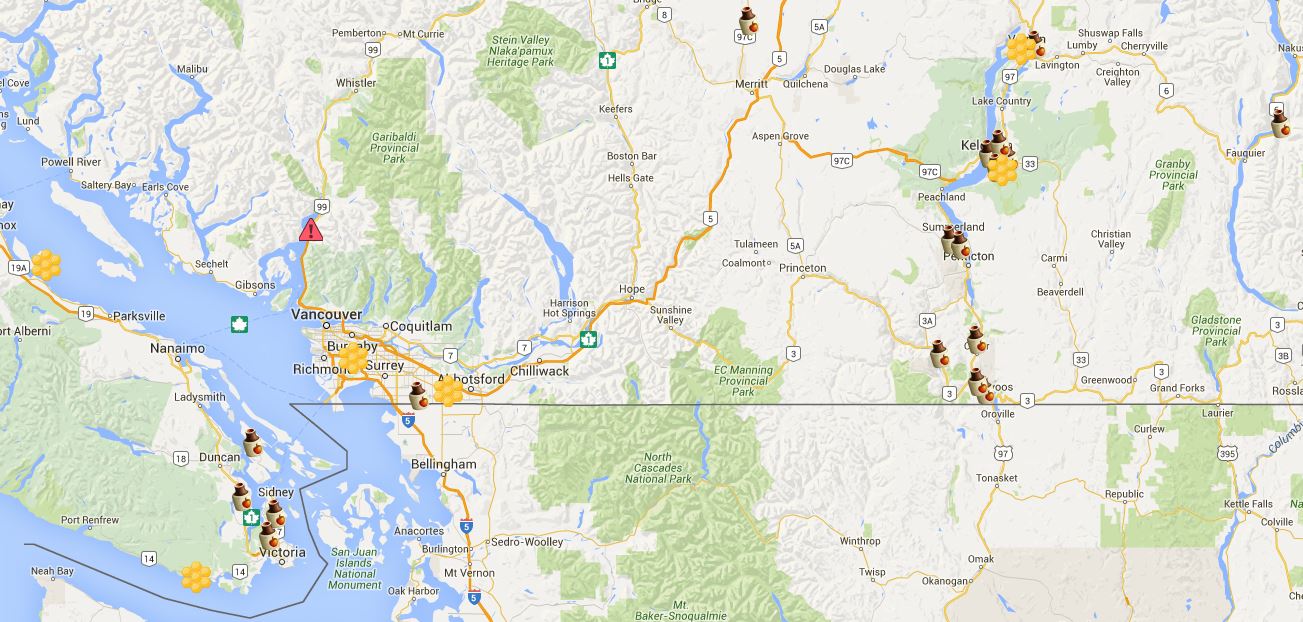
Spotlight on BC Craft Cider
Recently we featured a story which had been published on BC Business Magazine’s website. Its author, Jacob Parry, made some fantastic points about the state of the craft cider industry in BC. The thrust of the piece was that cider has long been, and still is, classified alongside wine in terms of BC liquor legislation, and is treated differently from beer. Parry’s story features an infographic which details an obstacle facing cider manufacturers: a different level of LDB markup. The difference in treatment, assuming that this part of his illustration is accurate, is striking.
Parry’s story does otherwise have a few flaws. As will be discussed later in this article, the number of currently operating craft cideries in BC is somewhat understated, and the recency of this industry niche is overstated. What’s Brewing is well aware of how long Merridale Cidery, a fixture every year at the Great Canadian Beer Festival, has been around; Parry seems to indicate that local orchard cideries turned up in 2012. (Also, there was a nasty typo in the title of the author’s original post, which has since been cleaned up). But What’s Brewing happily overlooks these points because they aren’t the focus of the article; the classification of cider as wine is.
Classifying and legislating cider–as well as mead–with wine rather than beer admittedly makes some sense from an ingredient point of view. It probably seemed fine a couple of decades ago when wine was ascendant and microbrewed beer wasn’t commonly called ‘craft’ yet. But with recent focus on the craft brewing industry paving the way for the continued growth of the craft beer trend, small cider producers might be left looking over the fence.
Ironically, some of those cider producers are brewers. Recently, at the Canadian Brewing Awards & Conference held in Richmond BC, Paul Hadfield of Spinnakers Gastro Brewpub delivered the keynote address, in which he touched on the cidery side of their business. After the presentation, your humble reporter was engaged in conversation with Mr. Hadfield as well as Richmond-based MLA John Yap, Parliamentary Secretary for Liquor Reform. I was therefore present when Paul turned to John and, with reference to the recent changes to small brewery taxation, remarked “Great job. Now, can we talk about cider”.
Hadfield isn’t the only brewer that may have mixed feelings about the progress craft has made in BC legislation, due to the way cider is classified. A glance at the list of licensed cideries in BC turns up a number of familiar brewery names, including “33 Acres Cider Company”, “Persephone Cider Works” and “Ravens Cider Company”. Some breweries, like Central City, are beginning to put significant resources into brewing with fruit. It’s only natural, since it appeals to the brewer’s creative instinct and is also a hot trend.
“Craft Cider” has been coming on for some time and seems poised to make its own breakthrough into the North American craft beverage mainstream in similar manner to beer’s success. Part of the reason is a recent mainstream trend toward sweeter alcoholic drinks. Indicative of this trend was Labatt’s acquisition of Mark Anthony Brands’ “ready-to-drink” cider and hard lemonade portfolio along with the Turning Point/Stanley Park brewing operation late last year. As reported by Just-Drinks, JP Morgan analyst Andrea Teixeira characterised the market as “likely growing volumes by high single digits to low double digits per year”.
Here in BC, growth in interest is represented by a recent rapid increase in the number of small cideries in operation. To “easily” view a list of registered cideries, one may browse to the BC government’s Winery Locations page, download the file and filter the listing for the word ‘cider’. Doing this turns up around 20 entries, or approximately the number quoted in Parry’s article–although his source, the Northwest Cider Association, indicated that only seven were in operation as of early 2016. Based on recent research, that number seems low. What’s Brewing had compiled a list of operating cideries back in February for its recently-released BC Craft Map & Directory, and the number was higher at that point; browsing the Facebook pages of various registrants reveals that even more of them are active this summer.
In addition to the cideries themselves, a great indicator of the health of the cider trend is the impending opening of Orchard & The Sea, billed as “British Columbia’s first cider bar and restaurant”. Also, CAMRA Vancouver’s annual Ciderwise event consistently sells out. Cider seems set to follow the path of craft beer, and indeed many in the craft beer fraternity (including us at What’s Brewing) see small cideries, meaderies and distilleries as our “craft cousins”.
This summer, What’s Brewing plans to tour the Okanagan region, where the largest number of cideries reside, and produce a focus piece on the craft cider scene for our Fall 2016 issue. We’ll be reporting back on what the cidery owners have to say about their situation. Maybe one day, cideries will get their own categorization, meaning that one won’t have to filter through a list of wineries to make a standalone map of them (Barley Mowat will rejoice). In the meantime, to view our curated map of BC cideries, pull up this page (and un-tick the non-cidery categories for a clearer view):
 What’s Brewing BC Craft Beverage Map
What’s Brewing BC Craft Beverage Map
More Craft Cider coverage
https://www.whatsbrewing.ca/2016/06/liquor-laws-craft-cider-disadvantage/
The Craft Cider Licensing Debate: farm or factory, beer or wine?
Announcing the Opening of Orchard & the Sea Craft Cider Bar!
This Post Has 0 Comments